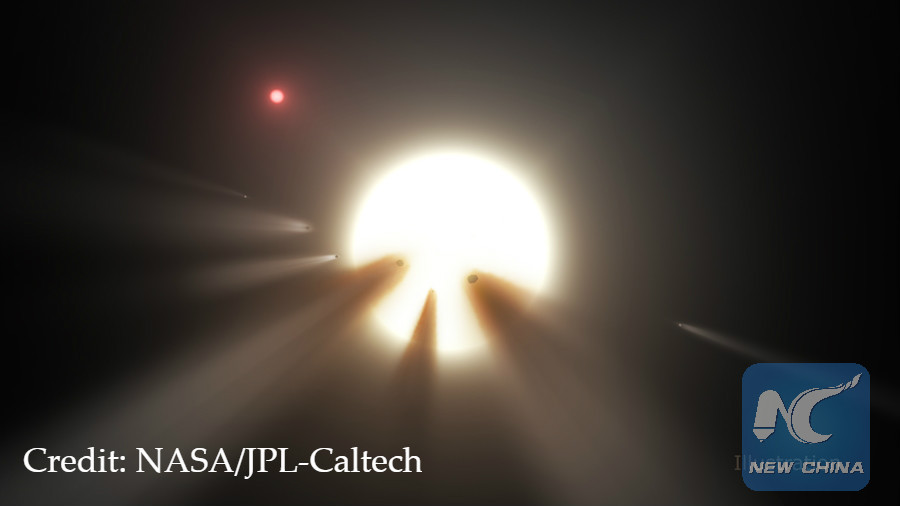
This illustration shows a star behind a shattered comet. Observations of the star KIC 8462852 by NASA's Kepler and Spitzer space telescopes suggest that its unusual light signals are likely from dusty comet fragments, which blocked the light of the star as they passed in front of it in 2011 and 2013. The comets are thought to be traveling around the star in a very long, eccentric orbit. (Credit: NASA/JPL-Caltech)
WASHINGTON, Jan. 3 (Xinhua) -- A team of more than 100 researchers is one step closer to solving the mystery behind the "most mysterious star in the universe," debunking the possibility that it is a structure made by aliens.
KIC 8462852, more than 1,000 light years away from the Sun, has been inexplicably dimming and brightening sporadically like no other stars.
It has spawned several theories explaining the star's unusual light patterns including an alien megastructure orbiting the star.
A new body of data collected by a team led by Tabetha Boyajian with Louisiana State University in partnership with the Las Cumbres Observatory is now available in a new paper in The Astrophysical Journal Letters.
It came after a campaign launched to unravel the mystery by a network of telescopes around the world.
"Dust is most likely the reason why the star's light appears to dim and brighten. The new data shows that different colors of light are being blocked at different intensities. Therefore, whatever is passing between us and the star is not opaque, as would be expected from a planet or alien megastructure," Boyajian said.
Jason Wright, co-author of the paper and an astrophysicist in Penn State University, said, "if the dips were the same depth at all wavelengths ... this would suggest that the cause was something opaque, like an orbiting disk, planet or star, or even large structures in space." Instead, the team found that the star got much dimmer at some wavelengths than at others.
The scientists closely observed the star through the Las Cumbres Observatory from March 2016 to December 2017. Beginning in May 2017, there were four distinct episodes when the star's light dipped.
"This latest research rules out alien megastructures, but it raises plausibility of other phenomena being behind the dimming," Wright said. "There are models involving circumstellar material -- like exocomets ... which seem to be consistent with the data we have."
Wright also said that "some astronomers favors the idea that nothing is blocking the star -- that it just gets dimmer on its own -- and this also is consistent with this summer's data."
The method in which this star is being studied signals a new era of astronomy. Citizen scientists, sifting through massive amounts of data from the NASA Kepler mission, were the ones to detect the star's unusual behavior in the first place.
The Kepler mission is to find planets, which it does by detecting the periodic dimming made from a planet moving in front of a star, and hence blocking out a tiny bit of starlight.
"If it wasn't for people with an unbiased look on our universe, this unusual star would have been overlooked," Boyajian said. "Again, without the public support for this dedicated observing run, we would not have this large amount of data."

